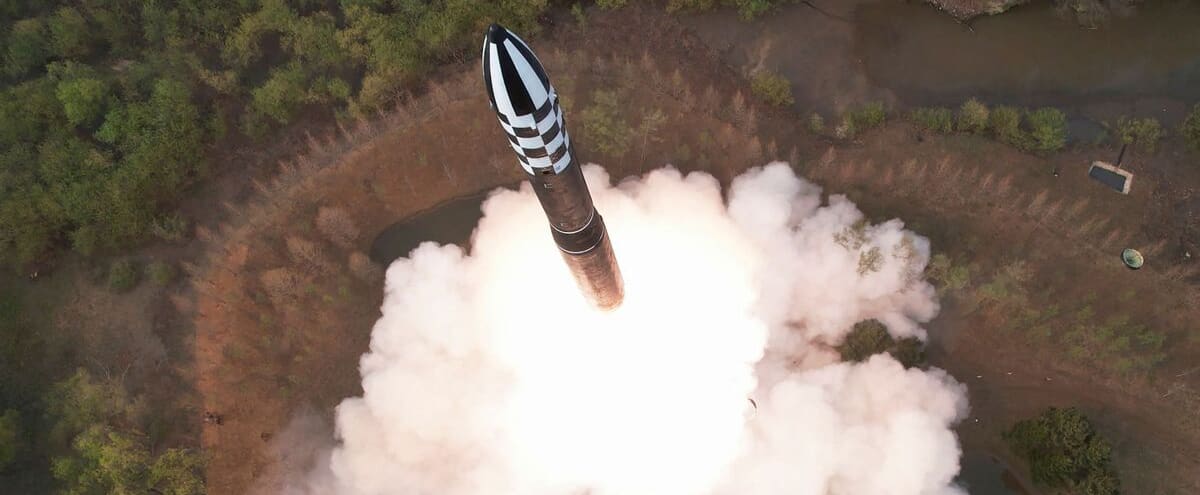North Korea on Friday affirmed that it had successfully launched its new solid-fuel intercontinental ballistic missile (ICBM), a major step forward for North Korea’s weapons program.
• Also read: North Korea confirms launch of solid ballistic missile
• Also read: Did North Korea launch a solid ballistic missile?
• Also read: North Korea fires ballistic missile, alarms Japan
But what is it and why has Pyongyang made this system a strategic priority?
Here’s what we know:
What is a solid fuel rocket?
This type of missile uses a fuel, the propellant, in solid form. It generates the thrust required for take-off.
“This propellant is loaded into the rocket’s cell once it’s built: imagine a fireworks rocket ready for action,” described AFP Ankit Panda, a US-based analyst.
Conversely, liquid-propellant rockets must be supplied with fuel and an oxidizer before launch. A slow and lengthy process.
Why are they stronger?
Preparing a liquid-fuel rocket “takes time, like putting gasoline in your car,” said Cheong Seong-chang, director of the Center for North Korean Studies at the Sejong Institute.
A solid fuel rocket, on the contrary, could be likened to a “portable battery”, giving the launch vehicle more flexibility.
In addition, once a rocket has been filled with liquid fuel, “it has to be ignited in a short time, which is not a problem with solid-fuel rockets,” adds the specialist.
However, they must be well stored and cared for. Otherwise, their quality may degrade and result in a launch failure, Mr. Panda notes.
However, solid-fuel rockets are easier to use than liquid-fuel rockets. This makes them “very attractive for a whole range of military applications”, specifies Ankit Panda.
Does North Korea have this type of missile?
Footage from North Korea’s official news agency KCNA shows the thick plume of exhaust gas emitted by the missile launched on Thursday. For Ankit Panda, “a solid propellant is at work.” “Everything seems to point to a successful test of solid fuel ICBMs,” he concludes.
But even if Pyongyang successfully passed this test, that doesn’t mean the system is ready to be deployed in large numbers, says Joseph Dempsey, a researcher at the International Institute for Strategic Studies.
North Korea’s tests of liquid-propelled ICBMs, although repeated, leave unanswered questions about this type of weapon. These projectiles actually followed a lobed trajectory different from that expected under real conditions.
However, North Korea appears to have different standards to other countries when it comes to operational readiness and can expect its new missile to be operational, according to Mr Dempsey.
For South Korea’s defense ministry, Thursday’s test was just a preliminary test and developing “Hwasong-18,” the name chosen by North Korea, “would take more time and effort.”
“Pyongyang still faces technical hurdles and resource constraints to effectively deploy the missiles that are being talked about in the state media,” Leif-Eric Easley, a professor at Ehwa University, told AFP.
What other countries do they have?
Most armies “start with liquid-fuel rocket technology, but quickly transition to solid-fuel rockets, which require more advanced technology,” Cheong said.
This does not imply exclusive use of these more advanced ICBMs.
“The United States only deploys solid-fuel ICBMs and strategic sea-to-surface ballistic missiles (SLBMs), but Russia and China still use large liquid-fuel missiles,” says Ankit Panda.
As for South Korea, it has the necessary technology and has solid-fuel missiles in its arsenal, “but their range is limited to the Korean peninsula,” Kim Jong-dae of the Institute of North Korean Studies in Yonsei told AFP University.
Are they game changers?
North Korean leader Kim Jong-un has claimed that the Hwasong-18 will “radically increase” his country’s nuclear counterattack capabilities. Experts agree that it cannot be ruled out that regional security will be changed.
South Korea’s self-defense plan is based on the “kill chain” system, which allows Seoul to launch pre-emptive strikes if there are signs of impending attacks from the north.
The Hwasong-18, with its solid fuel, would then be more difficult to detect, although South Korea’s defense ministry has described the fear as “undue concern”.
In the event of war, Seoul could launch pre-emptive strikes, but “after confirming signs the North was preparing to launch the missile,” he recalled.
“But there won’t be any such signs as the North Koreans prepare solid-fuel rockets aimed at the South.”

